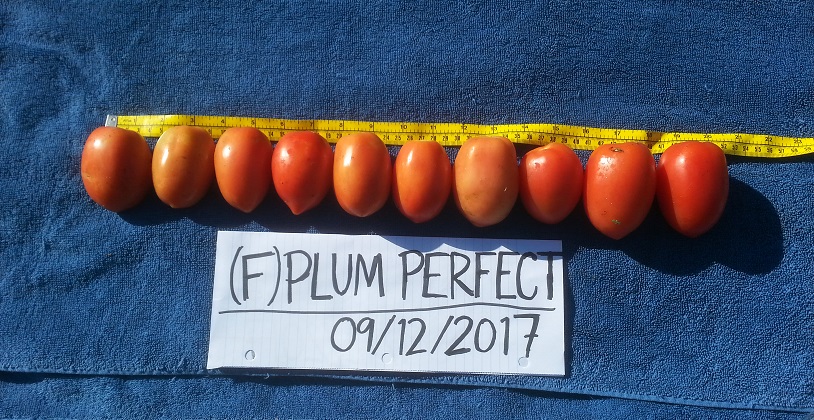Plum Perfect is a hybrid variety bred by Cornell University. As of my knowledge, Cornell is still looking for a company to license and sell this disease resistant variety. Plum Perfect is reportedly quite productive, and meaty. I also have not spent much time with the fruit, since this is a variety going directly to the farm stand for market. The disease resistance package includes Verticillium, Fusarium races 1 and 2, late blight (Ph3), tomato spotted wilt virus, bacterial speck, and nematode resistance. Interestingly enough, Plum Perfect is uniform ripening (u), a loss-of-function mutation that results in inactivation of the transcription factor SIGLK2. SIGLK2 is only expressed in fruit and controls accumulation and distribution of chlorophyll in the developing fruit. See Powell et al. (2012) for a discussion on how individuals with the uniform ripening (u) allele produce fruit with 20% less sugar and 20-30% less carotenoids when ripe. Unfortunately, this is a desirable characteristic for tomato processors and commercial producers.
During early season growth (in the greenhouse and field), Plum Perfect wasn’t a particular stand out. It was susceptible to the tomato leaf mold (Fulvia fulva) plaguing the farm’s unheated greenhouse. When Connor and I walked the field during the immature fruit stage, we thought the variability in fruit size would be a problem. But during our ripe fruit walk, we were both impressed with the “crazy nice” fruit set and clusters. We’re not totally sure if it’s right for our market, especially with it being so late to ripen.
Plum Perfect scored as the middle-man in our taste testings with the plum types. As a slow-roasted pasta sauce, it was better than Plum Regal, but paled compared to OSU LB8-7. They cooked down relatively fast (10 hours), but for whatever reason, Plum Perfect isn’t all that exciting for us.
First Ripe Fruit:
| Block 1 | Block 2 | Block 3 |
| August 22 | August 18 | August 29 |
All harvest data represents two Plum Perfect plants from each block, or six plants total:
Harvest 1 (September 5, 2017)
Picking Ease (5=easy, 1=difficult): 3
Marketable Fruit: 24 fruit weighing 2483g (5.47 lb.) Unmarketable Fruit: 6 fruit weighing 467g (1.03 lb.)
Reasons why unmarketable: zippers, too small
Harvest 2 (September 12, 2017)
Picking Ease (5=easy, 1=difficult): 4
Marketable Fruit: 26 fruit weighing 2453g (5.41 lb.) Unmarketable Fruit: 4 fruit weighing 288g (10.16 oz.)
Reasons why unmarketable: too small, zippers
Average Fruit Size: 5.18 cm x 6.93 cm (2.04″ x 2.73″)
Brix: 5.6, 5.1, 5.9
Harvest 3 (September 19, 2017)
Picking Ease (5=easy, 1=difficult): 2
Marketable Fruit: 29 fruit weighing 2960g (6.53 lb.) Unmarketable Fruit: 6 fruit weighing 491g (1.08 lb.)
Reasons why unmarketable: scabbing, too small, fruit damage
Harvest 4 (September 26, 2017)
Picking Ease (5=easy, 1=difficult): 4
Marketable Fruit: 31 fruit weighing 3185g (7.02 lb.) Unmarketable Fruit: 7 fruit weighing 458g (1.01 lb.)
Reasons why unmarketable: zippers, too small
Harvest 5 (October 3, 2017)
Picking Ease (5=easy, 1=difficult): 3
Marketable Fruit: 24 fruit weighing 2417g (5.33 lb.) Unmarketable Fruit: 12 fruit weighing 847g (1.87 lb.)
Reasons why unmarketable: too small, rot, scabbing

Leave a Reply